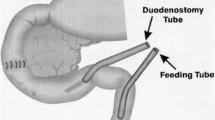Abstract
Clinically evident compromise of parietal or visceral pelvic function secondary to interruption of pelvic blood flow occurs infrequently after aortoiliac reconstruction. Certain patterns of aortoiliac or occlusive aneurysmal disease or graft infection may require exclusion of the hypogastric or profunda femoral arteries. In these situations collateral blood flow or retrograde iliac flow may be insufficient to perfuse the pelvis and may cause ischemia. We present three cases of postoperative pelvic ischemia and describe our efforts to restore pelvic perfusion.
Similar content being viewed by others
References
Iliopoulos J, Howanitz PE, Pierce GE, et al. The critical hypogastric circulation. Am J Surg 1987;154:671–675.
Brewster DC, Darling RC. Optimal methods of aortoiliac reconstruction. Surgery 1978;84:739–748.
O'Connor SE, Walsh DB, Zwolak RM, et al. Pelvic blood flow following aortobifemoral bypass with proximal end-to-side anastomosis. Ann Vasc Surg 1992;6:493–498.
Goldstone J, Malone JM, Moore WS. Importance of the profunda femoris artery in primary and secondary arterial operation for lower extremity ischemia. Am J Surg 1978;136:215–220.
Khodja RH, Batt M, Michetti C, et al. Radiologic anatomy of the anastomotic systems of the internal iliac artery. Surg Radiol Anat 1987;9:135–140.
Flanigan DP, Schuler MD, Keifer T, et al. Elimination of iatrogenic impotence and improvement of sexual function after aortoiliac revascularization. Arch Surg 1982;117:544–550.
Pierce GE, Turrentine M, Stringfield S, et al. Evaluation of end-to-side vs. end-to-end proximal anastomosis in aortobifemoral bypass. Arch Surg 1982;117:1580–1588.
Iliopoulos JI, Hemreck AS, Thomas JH, et al. Hemodynamics of the hypogastric arterial circulation. J Vasc Surg 1989;9:637–642.
Cronenwett JL, Gooch JB, Garrett EH. Internal iliac artery revascularization during aortofemoral bypass. Arch Surg 1982;117:838–839.
Segraves A, Rutherford RB. Isolated hypogastric artery revascularization after previous bypass for aortoiliac occlusive disease. J Vasc Surg 1987;5:472–474.
Merkel FK, Najarian JS. Rest pain of the buttock after aortofemoral bypass procedure: Report of an unusual case. Am J Surg 1971;121:617–619.
Pecoraro J, Wolodiger F, Dardik H. Retrograde profunda femoris bypass to prevent pelvic ischemia. In Bunt TJ, ed. Vascular Forum (in press).
Korthals JK, Wisniewski HM. Peripheral nerve ischemia: Part 1. Experimental model. J Neurol Sci 1975;24:65–76.
Picone AL, Green RM, Ricotta JR, et al. Spinal cord ischemia following operations on the abdominal aorta. J Vasc Surg 1986;3:94–103.
Author information
Authors and Affiliations
About this article
Cite this article
Paty, P.K.S., Shah, D.M., Chang, B.B. et al. Pelvic ischemia following aortoiliac reconstruction. Annals of Vascular Surgery 8, 204–206 (1994). https://doi.org/10.1007/BF02018871
Issue Date:
DOI: https://doi.org/10.1007/BF02018871




